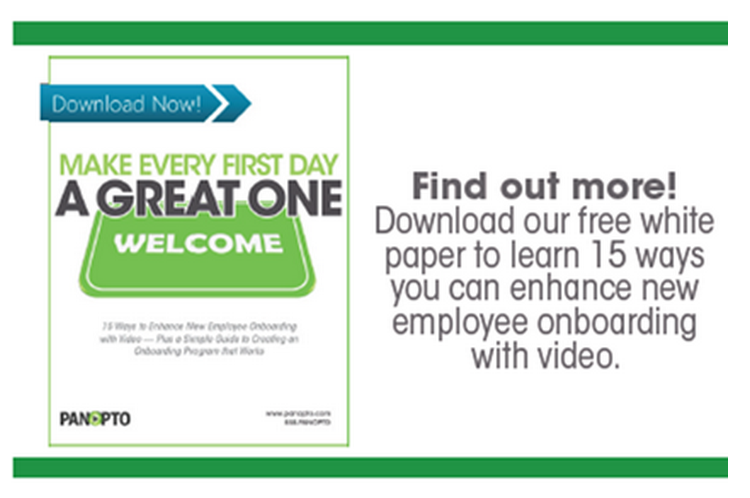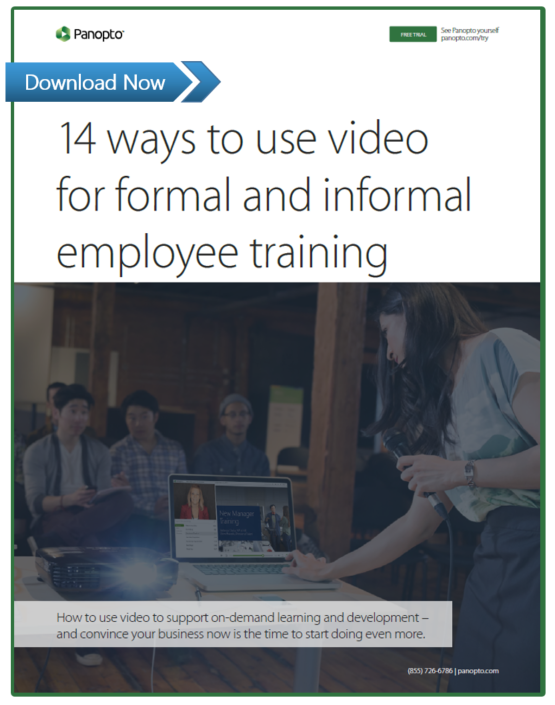- Communications
9 Opportunities to Enhance Formal Corporate Learning with Video
Not long ago, at Gartner’s U.S. Symposium, IT leaders from ten companies came together to brainstorm business use cases for video technology.
“Attendees first imagined more than thirty basic ideas, and then ranked them using a simple scale on which they measured each proposal’s cost benefit, revenue impact, risk, and emotional value,” Gartner reported. “A few best practices also emerged from that workshop, and from frequent conversations with Gartner clients about similar topics.”
The top use case Gartner uncovered: how-to videos for employees and customers. In other words, training videos.
Just how are modern organizations using video to support and scale their corporate learning and development activities? Let’s take a look at some of today’s latest trends and evolving strategies.
1: Improve the onboarding process
 No matter who they are or how much experience they may have, every new hire will need time to get up to speed. While no two positions will require exactly the same onboarding process, video training can help make the learning curve more manageable for everyone.
No matter who they are or how much experience they may have, every new hire will need time to get up to speed. While no two positions will require exactly the same onboarding process, video training can help make the learning curve more manageable for everyone.
To your new employees, that’s no trivial value. According to a BambooHR survey of employees who had quit a job within six months of starting:
- 23 percent felt they hadn’t received clear guidelines to their new responsibilities
- 21 percent said they wanted “more effective training”
A well-planned onboarding video library can help you share much more information with your new team members than would be possible face-to-face. Today, modern organizations are using onboarding videos to provide:
- Culture, vision and mission introductions. With video, a company’s most subtle, nuanced messages can be more effectively conveyed. Your mission and vision statements are guides to who your company is, where you’re going, and how you’ll get there. Sharing these in video helps makes those all-important principles easier for your team to find, to see, to share, and most importantly, to remember. The analysts agree — Gartner Research has identified vision and mission onboarding video as one of the five greatest-opportunity, lowest-risk ways organizations should be using video.
- Company tours. Sometimes, an in-person tour of the entire campus, including of safety-related locations, isn’t practical. Video tours of the workplace help employees settle in more quickly. And, contrary to what you may have heard, safety tours don’t have to be staid, boring or outdated. Today companies have brought creativity and a fresh perspective to the virtual tour — introducing team members, offering directions to essential locations, and sharing a bit of insider knowledge new teammates will appreciate.
- Organizational overviews. The employee onboarding process doesn’t have to be focused solely on the department in which the new hire will work. Many experts believe that interdepartmental training is key to the success of every employee, no matter what type of work they’re involved in. Larger organizations, in particular, do well to make sure all employees understand and feel part of the bigger picture. Welcome messages from executives and cross-departmental informational videos help to build a solid foundation for that understanding.
2: Make basic skills training universally available
Every organization has its own way of doing things:
- Scheduling meetings
- Booking conference rooms
- Signing emails
- Making conference calls
- Understanding acronyms
- And dozens — maybe even hundreds more
Within a few months of their first day, these are the skills every employee knows as second nature.
Yet those fundamentals aren’t always obvious to your new hire — in all likelihood, they’re used to someone else’s way of doing things, and often won’t know the right steps to take at your organization until they accidentally stray from the path. Here video can be a lifesaver, helping your new hire find the information they need to get the basics right.
Best of all, these recordings are some of the easiest to produce. Just use a screen recording tool and ask a member of the team to walk through the process the right way. Simple instructional videos — how to book a meeting or complete a tax form — may only need a single 3-5 minute video. Even systems that might be more complex — say, booking travel using the corporate agency, or understanding your annual review process and requirements — can often be taught with either a 10-20 minute review, or with a series of 3-5 minute videos each addressing specific elements of the overall system.
Along with ensuring that employees understand how to use your systems, basic skills training videos may also help boost the efficiency of your L&D team. Freed from routine how-to questions, your trainers can focus on new or more strategic work instead.
3: Actually show how your product or service works
There’s a dirty little secret most organizations hate to admit — many of your people have at best only a passing understanding of how your products actually work. And likely even fewer can accurately describe how your customers use your offering, or how it differs from your competition’s.
Especially for those organizations with technically or mechanically complex offerings, or those targeting a market their employees aren’t a natural part of — including virtually every B2B business out there — it’s just too difficult for a person to learn every last detail about what you do. Unless you show them.
Recording and sharing product information and demonstration videos can provide that extra level of insight that helps an organization develop the best, most knowledgeable team. Today organizations are working to show everything about how their products and services work:
- Field videos shot with a smartphone showing a new product in action,
- Screen recordings from the IT team illustrating the effects of a new line of code,
- End-to-end walkthroughs of the production floor and how each individual machine is used,
- Product positioning videos that illustrate benefits vs. a competitor’s product,
- And any number of other ways to show what the company does, in action.
These videos help your team actually see and understand the products and services your company offers — including what makes them different, what makes them valuable, and what makes them worth buying.
Watch an example product training video below:
4: Break down organizational silos
Few businesses can credibly claim to have no silos in their corporate structure. Most of us know well where the org chart overlaps and where it doesn’t — and when teams don’t naturally cross paths from time to time, there is often little opportunity for employees to learn about what their colleagues on those teams are working on.
The effect is even worse in practice — when teams don’t understand each other’s work, they tend to collaborate poorly (if at all). The potential for delayed programs, budget misunderstandings, and interpersonal fallout looms large.
Cross-departmental training has sprung up as a solution to this issue — helping employees better understand how each part of the business functions by training them on the basics of each group. The challenge: rolling out a cross-training system that is efficient and cost-effective.
And that’s the role that video fills. Teams can discuss the fundamentals of what they do and why it’s essential so that others can review anytime, on-demand. Local management can easily share these videos in the new hire onboarding processes or as part of kickoff for interdepartmental projects, helping to ensure everyone understands where each other is coming from.
5: Provide coaching for new management
Investing time, energy and financial resources in management training impacts a company’s success in more than one way.
The first: lower employee turnover. Organizations that make manager training and development a budgetary priority typically lose fewer employees — both managers and individual contributors — every year.
And those employees that stay? Under well-trained managers, their job performance improves. In fact, research shows that training and education are more accurate measures of an organization’s success than many other highly-regarded statistics, including price-to-earning ratios, price-to-price statistics, and measures of risk and volatility.
More and more businesses are recognizing the impact of proper management training, adding new programs, mentorship opportunities, and coaching processes each year. But in an era where managers are more pressed for time than ever before, many organizations are finding that video can help ensure new managers get the opportunity to fully experience an organization’s management training.
Supporting management training with video allows new managers to view each training course when it fits into their schedules, helping them take time to really engage with the content and better understand it. And with video, managers can instantly replay segments should they want to review a point for clarification.
Video may also be a valuable tool for traditional management training efforts as well. Management coaches may find that recording a manager’s interactions with her team — say, during an annual review or in a weekly performance meeting — may help them provide specific feedback to the manager and better tips for improving their own performance.
Watch an example employee coaching video below:
6: Provide anytime, anywhere training for front-line employees
For many businesses, your front-line staff such as retail employees and customer service, are the face of your organization. Buyers see these team members as direct extensions of the company, and expect them to have answers for just about any question.
This creates a significant hurdle for those businesses — as the front lines can often be where turnover is greatest. Local managers across many industries are in effect always hiring — and for the L&D team, that means new hires may be starting anytime, anywhere, often without anyone more senior than the local manager to show them the ropes.
For the most part, the gap this creates in the new hire’s access to training isn’t earth-shattering — but over time, the lack of a consistent training program can easily lead to remote offices and personnel following their own processes, making your customers’ experiences less consistent location-to-location and possibly making it harder for other parts of your organization to work with the maverick office.
To assist these often decentralized employees, learning and development teams are turning to video to provide a consistent training experience for all employees — and one that’s available anytime and anywhere, even on employee’s tablets and smartphones if needed. Customer associate training today can include:
- Basic how-tos, covering point-of-sale systems or other technology
- Corporate sales strategy, including tips for opening and closing sales discussions
- Tips for best producing or showing the product on-location
- And dozens of other points that can help the front line execute efficiently
Watch an example social learning video below:
7: Improve your sales enablement practice
Your sales team is often the single most important connection your company has with your prospects and clients.  Most organizations work diligently to supply their sales teams with all the tools, information, and other resources they need to ensure the sales process works its best — only to find the team isn’t making use of it all. According to Accenture:
Most organizations work diligently to supply their sales teams with all the tools, information, and other resources they need to ensure the sales process works its best — only to find the team isn’t making use of it all. According to Accenture:
- 90 percent of sales materials are not used by salespeople;
- 80 percent of training is not retained after 60 days;
- Salespeople spend 71% of time not selling; and
- CRM tool adoption rates by salespeople are less than 50%;
- Proper sales methodology is used less than half of the time
Often it’s communication at the root of these missed opportunities. Sales staff are among the busiest at just about any organization — all but the most engaging information may be lost in the shuffle of client visits, new business calls, and more. Further complicating issues, most sales teams are spread across a market — even around the world — hindering the company’s ability to bring the team together for a quick update or demonstration.
Video, of course, can help with that. Modern organizations are finding opportunity for video throughout the sales enablement practice, with demonstrated success in:
- Sharing product news, updates, and demonstrations
- Providing corporate or sales strategy updates
- Peer-to-peer social learning and best practice sharing
- Enhanced customer and prospect communications
For many sales enablement teams, video is more than a welcome helping hand, it’s creating a competitive advantage — boosting onboarding and training, enhancing communications, and attracting and connecting with prospects.
8: Ensure everyone has taken compliance training
Your ability to educate employees on the laws, regulations and company policies that apply to their daily job responsibilities is critical. And an effective compliance training program does more than just reduce regulatory and legal risk. It also helps foster a positive corporate culture built on accountability, integrity, and respectful interaction.
According to Forrester Research, “Employees need easy access to formal learning like required compliance or regulatory training.” Using video, employees can access this information when they join the company, during annual compliance policy updates, or anytime from any device. A range of compliance topics that span industries can be covered in an illustrative way using video, including:
- Fair and respectful working conditions policies;
- Safety location virtual tours;
- Fair competition regulations;
- Foreign trade law compliance;
- Intellectual property protection;
- Transparency in financial reporting; and
- Integrity in business interactions.
Video training can be an especially effective way to cover delicate and important compliance issues, including emergency procedures, sexual harassment laws, and more.
And not only does video provide an ideal medium for these topics, the technology can also help you ensure your employees are actually completing these essential courses. Video analytics included in many modern video platforms offer user-level detail, allowing your team to know whether an employee had viewed a video, and if they watched it through to the end.
9: Expand the reach of your conferences
Even as remote training by video becomes commonplace, often there is simply no substitute for a live event. More and more organizations are finding that marquee events, be they internal-only conventions or industry-focused public conferences, are extremely valuable tools for sharing information, connecting employees with each other or the industry, and educating a large audience all at once.
Attending these events can boost employee morale and engagement in a way that’s almost impossible to replicate during business-as-usual moments. But for oft-cited reasons of timing and budget, attendance is seldom possible for every event and every member of your team.
When attendance isn’t possible, a video recording of the event can be the next best thing. Recording events — or even live-streaming them — can be a great way to share the excitement and insight gleaned from all those keynotes and breakouts, with anyone, anytime, anywhere.
Event video used to be an expensive and complicated production limited to the domain of technical AV experts outfitted with expensive hardware. Today, however, all it takes are simple webcams and software to capture, share, and even live-stream HD video of events of any size to audiences all around the world. Today Siemens PLM has done just that, simplifying video production at the company’s worldwide events while cutting costs and reducing the amount of time required to produce and share conference videos.
Find Out More! In our latest white paper, 14 Ways to Use Video for Formal and Informal Learning, we help L&D practitioners make the business case for doing more with video, including:
In our latest white paper, 14 Ways to Use Video for Formal and Informal Learning, we help L&D practitioners make the business case for doing more with video, including:
- 5 benefits that help convince your decision makers to use video in more ways for L&D
- 14 ideas for supporting and scaling formal and informal learning with video
- 1 technology — the video platform — that simplifies the use of video for L&D
Today’s learning and development professionals already understand the potential that video technology offers. Make sure your organization isn’t missing out!



